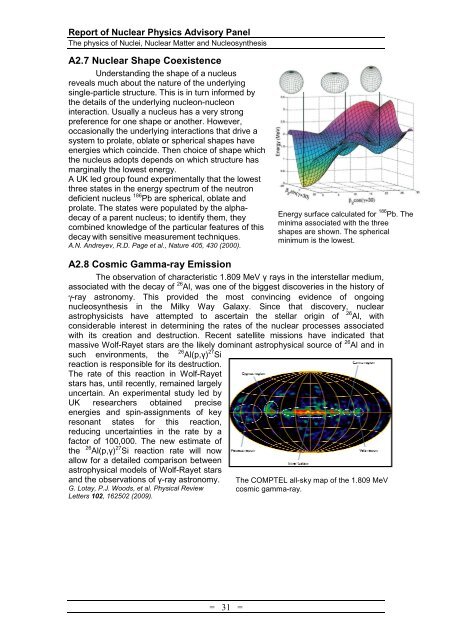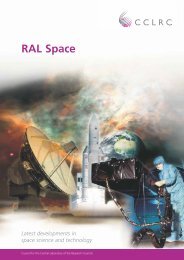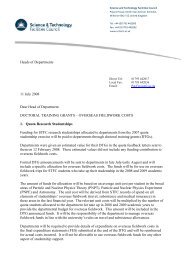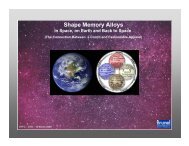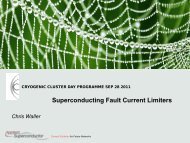Nuclear Physics Advisory Panel (NPAP) report (PDF-3.8 MB) - STFC
Nuclear Physics Advisory Panel (NPAP) report (PDF-3.8 MB) - STFC
Nuclear Physics Advisory Panel (NPAP) report (PDF-3.8 MB) - STFC
You also want an ePaper? Increase the reach of your titles
YUMPU automatically turns print PDFs into web optimized ePapers that Google loves.
Report of <strong>Nuclear</strong> <strong>Physics</strong> <strong>Advisory</strong> <strong>Panel</strong><br />
The physics of Nuclei, <strong>Nuclear</strong> Matter and Nucleosynthesis<br />
A2.7 <strong>Nuclear</strong> Shape Coexistence<br />
Understanding the shape of a nucleus<br />
reveals much about the nature of the underlying<br />
single-particle structure. This is in turn informed by<br />
the details of the underlying nucleon-nucleon<br />
interaction. Usually a nucleus has a very strong<br />
preference for one shape or another. However,<br />
occasionally the underlying interactions that drive a<br />
system to prolate, oblate or spherical shapes have<br />
energies which coincide. Then choice of shape which<br />
the nucleus adopts depends on which structure has<br />
marginally the lowest energy.<br />
A UK led group found experimentally that the lowest<br />
three states in the energy spectrum of the neutron<br />
deficient nucleus 186 Pb are spherical, oblate and<br />
prolate. The states were populated by the alphadecay<br />
of a parent nucleus; to identify them, they<br />
combined knowledge of the particular features of this<br />
decay with sensitive measurement techniques.<br />
A.N. Andreyev, R.D. Page et al., Nature 405, 430 (2000).<br />
Energy surface calculated for 186 Pb. The<br />
minima associated with the three<br />
shapes are shown. The spherical<br />
minimum is the lowest.<br />
A2.8 Cosmic Gamma-ray Emission<br />
The observation of characteristic 1.809 MeV γ rays in the interstellar medium,<br />
associated with the decay of 26 Al, was one of the biggest discoveries in the history of<br />
γ-ray astronomy. This provided the most convincing evidence of ongoing<br />
nucleosynthesis in the Milky Way Galaxy. Since that discovery, nuclear<br />
astrophysicists have attempted to ascertain the stellar origin of<br />
26 Al, with<br />
considerable interest in determining the rates of the nuclear processes associated<br />
with its creation and destruction. Recent satellite missions have indicated that<br />
massive Wolf-Rayet stars are the likely dominant astrophysical source of 26 Al and in<br />
such environments, the<br />
26 Al(p,γ) 27 Si<br />
reaction is responsible for its destruction.<br />
The rate of this reaction in Wolf-Rayet<br />
stars has, until recently, remained largely<br />
uncertain. An experimental study led by<br />
UK researchers obtained precise<br />
energies and spin-assignments of key<br />
resonant states for this reaction,<br />
reducing uncertainties in the rate by a<br />
factor of 100,000. The new estimate of<br />
the 26 Al(p,γ) 27 Si reaction rate will now<br />
allow for a detailed comparison between<br />
astrophysical models of Wolf-Rayet stars<br />
and the observations of γ-ray astronomy.<br />
G. Lotay, P.J. Woods, et al. Physical Review<br />
Letters 102, 162502 (2009).<br />
The COMPTEL all-sky map of the 1.809 MeV<br />
cosmic gamma-ray.<br />
= 31 =


